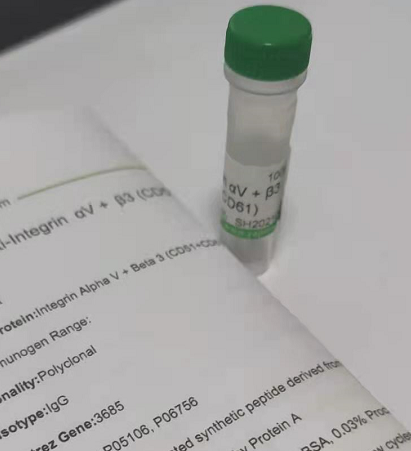| 產(chǎn)品編號 | Ys-1213R |
| 英文名稱 | TRAF2 |
| 中文名稱 | 腫瘤壞死因子受體相關因子2抗體 |
| 別 名 | TNF receptor-associated factor 2; E3 ubiquitin-protein ligase TRAF2; TNF-R2; TNF R2; MGC:45012; TNF receptor associated factor 2; TNF receptor-associated protein; TRAF 2; TRAF2_HUMAN; TRAP 3; TRAP; TRAP3; Tumor necrosis factor type 2 receptor associated protein 3; Tumor necrosis factor type 2 receptor-associated protein 3. |
| 抗體來源 | Rabbit |
| 克隆類型 | Polyclonal |
| 交叉反應 | Human, (predicted: Mouse, Rat, ) |
| 產(chǎn)品應用 | WB=1:500-2000 ELISA=1:5000-10000 IHC-F=1:100-500 Flow-Cyt=1μg/Test IF=1:100-500 (石蠟切片需做抗原修復) not yet tested in other applications. optimal dilutions/concentrations should be determined by the end user. |
| 理論分子量 | 56kDa |
| 細胞定位 | 細胞漿 |
| 性 狀 | Liquid |
| 濃 度 | 1mg/ml |
| 免 疫 原 | KLH conjugated synthetic peptide derived from human TRAF2: 401-501/501 |
| 亞 型 | IgG |
| 純化方法 | affinity purified by Protein A |
| 緩 沖 液 | 0.01M TBS(pH7.4) with 1% BSA, 0.03% Proclin300 and 50% Glycerol. |
| 保存條件 | Shipped at 4℃. Store at -20 °C for one year. Avoid repeated freeze/thaw cycles. |
| 注意事項 | This product as supplied is intended for research use only, not for use in human, therapeutic or diagnostic applications. |
| PubMed | PubMed |
| 產(chǎn)品介紹 | The induction of the various cellular responses mediated by tumor necrosis factor is initiated by its interaction with the TNFR1 and TNFR2 cell surface receptors. TRAF2 interacts with the cytoplasmic domain of TNFR2. TRAF2 is a common signal transducer for TNFR2 and CD40 that mediates activation of NF kappa B. Function: Regulates activation of NF-kappa-B and JNK and plays a central role in the regulation of cell survival and apoptosis. Required for normal antibody isotype switching from IgM to IgG. Has E3 ubiquitin-protein ligase activity and promotes 'Lys-63'-linked ubiquitination of target proteins, such as BIRC3, RIPK1 and TICAM1. Is an essential constituent of several E3 ubiquitin-protein ligase complexes, where it promotes the ubiquitination of target proteins by bringing them into contact with other E3 ubiquitin ligases. Regulates BIRC2 and BIRC3 protein levels by inhibiting their autoubiquitination and subsequent degradation; this does not depend on the TRAF2 RING-type zinc finger domain. Isoform 2 does not seem to mediate activation of NF-kappa-B but inhibits isoform 1 activity. Plays a role in mediating activation of NF-kappa-B by EIF2AK2/PKR. Subunit: Homotrimer, and heterotrimer with TRAF1 and TRAF3 (via TRAF domain). The domain containing the RING-type and the first TRAF-type zinc finger can also form homodimers (in vitro). Interacts with TNFRSF1B/TNFR2, TNFRSF4, TNFRSF5/CD40, CD27/TNFRSF7, TNFRSF8/CD30, TNFRSF9/CD137, TNFRSF11A/RANK, TNFRSF13B/TACI, TNFRSF14, TNFRSF16/NGFR, TNFRSF17/BCMA, TNFRSF18/AITR, TNFRSF19/TROY, TNFRSF19L/RELT, XEDAR, EDAR, Epstein-Barr virus BNFL1/LMP-1 and IL15RA. Interacts with CDK9, CSK, MAP3K1, MAP3K5, MAP3K11, MAP3K14, MAP4K2, RIPK1, RIPK2, TNIK, TBK1, SPHK1, TRADD, TRAFD1, TRAIP, TANK/ITRAF, TNFAIP3, TDP2, MAVS/IPS1, TICAM1 and TRPC4AP. Interacts with CASP8AP2, NFATC2IP, PEG3 and HIVEP3. Interacts with BIRC2 and BIRC3 N-terminus; a single BIRC2 or BIRC3 molecule interacts with a heterotrimer formed by TRAF1 and TRAF2, or a TRAF2 homotrimer. Identified in a complex composed of TRAF2, TRAF3, BIRC2 and/or BIRC3. Interaction with BIRC2 and/or BIRC3 is essential for degradation of NFKBIA and activation of NF-kappa-B. Interacts with CYLD, USP48, IKKA and IKKB. Interacts (via 'Lys-63'-linked polyubiquitin chains) with TAB2 and TAB3 (By similarity). Interaction with TAOK3 is facilitated under ER stress conditions, such as treatment with tunicamycin, and may promote TRAF2 phosphorylation (By similarity). Interacts with CASP12 under resting conditions; this interaction is reduced in ER stress conditions. Interacts (via zinc fingers) with DAB2IP (via C-terminus PER domain); the interaction occurs in a TNF-alpha-dependent manner (By similarity). Interacts with ERN1; the interaction requires DAB2IP. Interacts with DAB2IP. Interacts (via C-terminus) with EIF2AK2/PKR (via the kinase catalytic domain) (By similarity). Subcellular Location: Cytoplasm. Tissue Specificity: isoform 1 and isoform 2 are expressed in spleen, adipose tissues, skeletal muscles, thymus, testis, heart, lung, brain. Isoform 2 is very weakly expressed in heart, lung and brain. Post-translational modifications: Phosphorylated at several serine residues within the first 128 amino acid residues. Phosphorylated at Thr-117 in response to signaling via TNF and TNFRSF1A. Phosphorylation at Thr-117 is required for 'Lys-63'-linked polyubiquitination, but not for 'Lys-48'-linked polyubiquitination. Phosphorylation at Thr-117 is important for interaction with IKKA and IKKB, activation of IKK and subsequent activation of NF-kappa-B (By similarity). Undergoes both 'Lys-48'-linked and 'Lys-63'-linked polyubiquitination. Polyubiquitinated via 'Lys-63'-linked ubiquitin in response to TNF signaling; this requires prior phosphorylation at Thr-117. 'Lys-63'-linked polyubiquitination promotes TRAF2-mediated activation of NF-kappa-B. Can be polyubiquitinated at several Lys residues via 'Lys-48'-linked ubiquitin chains in response to TNF signaling, leading to proteasomal degradation. Autoubiquitinated, leading to its subsequent proteasomal degradation. Polyubiquitinated by BIRC2 and SIAH2, leading to its subsequent proteasomal degradation. Not ubiquitinated by BIRC3 or SIAH1. Deubiquitinated by CYLD, a protease that specifically cleaves 'Lys-63'-linked polyubiquitin chains (By similarity). Similarity: Belongs to the TNF receptor-associated factor family. A subfamily. Contains 1 MATH domain. Contains 1 RING-type zinc finger. Contains 2 TRAF-type zinc fingers. SWISS: Q12933 Gene ID: |
我要詢價
*聯(lián)系方式:
(可以是QQ、MSN、電子郵箱、電話等,您的聯(lián)系方式不會被公開)
*內(nèi)容:









